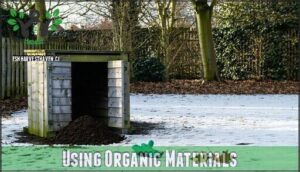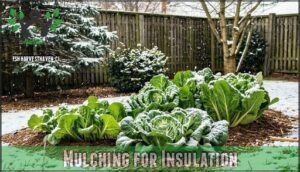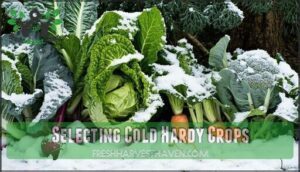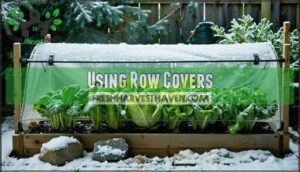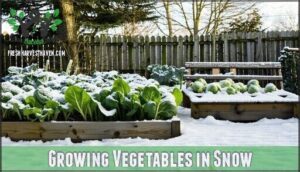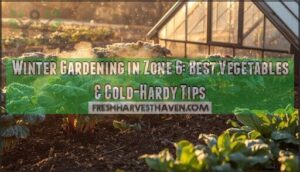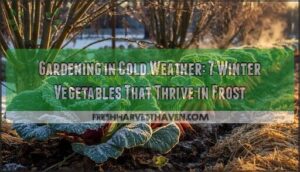This site is supported by our readers. We may earn a commission, at no cost to you, if you purchase through links.
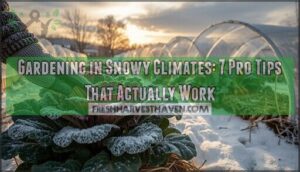 You can successfully grow vegetables during winter by selecting cold-hardy crops like kale, carrots, and Brussels sprouts that actually sweeten after frost exposure. Choose varieties specifically bred for cold tolerance—many brassicas and root vegetables thrive in temperatures that would kill summer crops. Time your plantings so crops mature before the harshest weather hits, usually 10-12 weeks before your first hard freeze.
You can successfully grow vegetables during winter by selecting cold-hardy crops like kale, carrots, and Brussels sprouts that actually sweeten after frost exposure. Choose varieties specifically bred for cold tolerance—many brassicas and root vegetables thrive in temperatures that would kill summer crops. Time your plantings so crops mature before the harshest weather hits, usually 10-12 weeks before your first hard freeze.
Start by preparing your soil in fall with organic matter and compost tea applications before the ground freezes. Use row covers and mulch layers to create protective microclimates that can raise soil temperatures by 10-15 degrees.
The secret lies in working with winter’s natural rhythms rather than fighting them.
Table Of Contents
- Key Takeaways
- Winter Gardening Basics
- Soil Preparation Methods
- Selecting Cold Hardy Crops
- Protecting Crops From Frost
- Growing Vegetables in Snow
- Frequently Asked Questions (FAQs)
- Can vegetables grow in snow?
- Can plants survive snow?
- What plants grow in winter?
- What vegetables and herbs grow in snow & cold?
- Is winter gardening a good idea?
- Can you grow a garden in winter?
- How cold is too cold for garden plants?
- Can you grow vegetables in the snow?
- What is the lowest temperature a garden can handle?
- What month do you start a winter garden?
- Conclusion
Key Takeaways
- Start with cold-hardy varieties – You’ll get better results growing kale, Brussels sprouts, and root vegetables that actually sweeten after frost hits, rather than trying to protect tender crops through winter.
- Time your plantings strategically – You need to plant 10-12 weeks before your first hard freeze so crops reach 75% maturity before harsh weather arrives and daylight drops below 10 hours.
- Layer your protection methods – You can’t rely on just one technique; combine row covers, mulch, and cold frames to create microclimates that raise temperatures by 10-15 degrees around your plants.
- Prepare soil before winter hits – You’ll need to build soil structure with organic matter and compost in fall while microorganisms are still active, since frozen ground won’t process nutrients effectively.
Winter Gardening Basics
Winter gardening requires strategic planning to enhance success in cold conditions. You’ll need to adjust traditional growing methods by avoiding summer crop beds, reducing soil disturbance, and timing fertilizer applications when soil microbes remain active.
Avoiding Summer Crop Interference
Separate your winter vegetable gardening beds from summer plantings to prevent soil temperature control issues and nutrient competition. This garden bed management strategy facilitates effective crop rotation plans while maintaining soil health.
Clean summer debris before establishing winter crop production areas. Seasonal planting in dedicated spaces guarantees cold hardy crops receive favorable growing conditions.
Smart harvest timing strategies work best when you avoid overlapping crops, promoting successful extending growing season efforts through strategic winter gardening practices.
Minimizing Soil Tilling
Your winter garden thrives when you ditch heavy tilling for soil conservation methods. Reduced tilling preserves the intricate soil food web that cold climate gardening depends on. These no-till methods deliver outstanding results:
- Protects beneficial microorganisms essential for nutrient cycling
- Maintains soil structure preventing erosion control issues
- Preserves existing mulch layers for natural winter gardening protection
- Reduces compaction allowing better root penetration through minimal disturbance
Smart soil preparation means working with nature’s existing framework.
Organic Fertilizer Application
Your garden’s nutrient needs shift dramatically when temperatures drop. Winter fertilizers require strategic timing since soil amendments work differently in cold conditions. Apply organic matter like bone meal during fall’s warmer periods when soil microorganisms remain active enough to process nutrients effectively.
Compost tea provides immediate natural nutrients that frozen ground can absorb quickly. Smart application timing guarantees your winter hardy crops receive consistent feeding throughout the season. Cold climate gardening demands patience – nutrients release slowly but steadily.
Your soil preparation for winter strategy:
- Brew compost tea weekly – liquid nutrients penetrate frozen soil layers
- Apply bone meal in late October – slow-release phosphorus feeds roots
- Top-dress with finished compost – maintains soil biology through winter
- Mulch heavily after fertilizing – prevents nutrient leaching from snow melt
Soil Preparation Methods
Proper soil preparation forms the foundation of successful winter gardening, requiring specific techniques that differ from summer practices. You’ll need to focus on building soil structure and insulation before cold weather arrives, using organic materials and mulching strategies that protect your crops through snow and freezing temperatures.
Using Organic Materials
Understanding composting methods builds the foundation for success during frozen months. Compost application boosts earthworm populations by up to 75% in cold climates, creating a living network beneath your winter garden. This organic amendment enriches soil with essential macronutrients while supporting soil biodiversity through sustained microbial activity.
Building soil health through organic materials creates the underground support system your winter crops desperately need.
Green manures increase nitrogen content by 20-55%, providing slow-release nutrition throughout snowy seasons. Well-aged manure applied in autumn improves water retention while reducing soil compaction by approximately 30%. These sustainable sourcing practices feed soil microbes first, establishing a thriving ecosystem that continues functioning even under snow cover. Many gardeners find outdoor compost containers to be an essential tool.
Organic amendments like leaf mold add 15-25% more humus compared to synthetic alternatives, strengthening soil structure for improved winter resilience and long-term fertility gains.
Mulching for Insulation
Strategically applying organic mulch materials transforms your winter garden into a fortress against harsh conditions. Layer straw, shredded leaves, or wood chips around cold hardy crops to maintain ideal winter soil temperature and create effective snow insulation for plants.
These insulation techniques deliver multiple benefits:
- Frost protection methods keep root zones consistently warmer
- Snow retention strategies prevent damaging freeze-thaw cycles
- Moisture conservation reduces plant stress during dormant periods
This approach helps your vegetables survive winter’s worst while maintaining soil health for spring growth. Understanding soil preparation basics is vital for creating a thriving winter garden.
Selecting Cold Hardy Crops
Selecting the right cold-hardy vegetables transforms your winter garden from a frozen wasteland into a productive food source. You’ll need to focus on three main categories: cole crops that thrive in freezing temperatures, hardy brassicas that actually taste better after frost, and root vegetables that can stay buried under snow until you’re ready to harvest them.
Cole Crops and Varieties
With your soil prepared, cole crops become your winter garden’s heavy hitters. Broccoli varieties like ‘Purple Sprouting’ and cauliflower types such as ‘Snow Crown’ concentrate sugars when temperatures drop, creating sweeter flavors than summer harvests. Kale delivers exceptional kale nutrition while ‘Winterbor’ survives brutal cold. Brussels sprouts improve after frost exposure, and cabbage varieties resist common cabbage diseases.
Choose cultivars bred for winter hardiness—’January King’ cabbage and ‘Long Island Improved’ sprouts handle repeated freeze-thaw cycles. These powerhouse vegetables thrive where tender crops fail. Understanding cold hardy vegetables is vital for selecting the right crops for your winter garden.
Brassica Vegetables
Broccoli and Brussels sprouts thrive in cold temperatures, developing concentrated sugars that intensify flavor. Cauliflower and cabbage resist pests better in cool weather, while kale withstands frost remarkably well. Tatsoi grows rapidly in fall conditions, providing tender leaves for winter harvests.
Here are four brassica varieties that’ll transform your winter garden:
- Purple Top Brussels Sprouts – Sweet, nutty flavor after first frost
- Winterbor Kale – Curly leaves packed with kale benefits and cold tolerance
- Snow Crown Cauliflower – Quick-maturing heads perfect for broccoli recipes adaptations
- January King Cabbage – Purple-tinged leaves ideal for cabbage storage
Focus on brassica nutrition by selecting cold-hardy cultivars. These vegetables concentrate nutrients when stressed by cold, making tatsoi preparation and other brassicas more flavorful than summer crops. For ideal growth, understanding seed quality factors is vital for gardeners.
Root Vegetables for Winter
Beyond brassicas, root vegetables offer unparalleled winter reliability. Carrots and parsnips develop concentrated sweetness after frost exposure, while turnips and beets maintain excellent storage capabilities. These hardy crops tolerate snow cover naturally, requiring minimal protection.
| Vegetable | Storage Method | Harvest Timing | Frost Tolerance | Flavor Notes |
|---|---|---|---|---|
| Carrots | In-ground or sand boxes | Late fall through winter | -10°F | Sweeter after frost |
| Parsnips | Leave in soil until spring | After hard frost | -20°F | Best for winter recipes |
| Turnips | Root cellar storage | Before hard freeze | 15°F | High nutritional value |
| Beets | Sand-filled containers | Mid to late fall | 25°F | Excellent beet storage option |
| Radishes | Quick harvest cycles | 30-60 days | 20°F | Simple radish cultivation |
Protecting Crops From Frost
When frost threatens your winter garden, you’ll need reliable protection methods to keep your crops alive. The right combination of covers, structures, and mulch can mean the difference between a thriving winter harvest and frozen disappointment.
Using Row Covers
Row covers transform your winter garden into a protective sanctuary that shields cold-hardy vegetables from harsh weather conditions. These lightweight fabrics create a microclimate that’s 2-7°F warmer than outside temperatures, making winter harvest strategies more successful.
Choose spunbonded polypropylene row cover materials for ideal frost protection methods. Heavy-duty covers (1.5 oz/sq yd) withstand temperatures down to 20°F, while lighter options work for mild frosts.
Master these crop insulation techniques:
- Install covers immediately after planting for maximum protection
- Secure edges with rocks to prevent snow load management issues
- Use hoops to keep fabric off plants during growth
- Monitor humidity levels to prevent fungal problems
Double-layering increases internal temperatures by 10-27°F during extreme cold snaps. These cold weather gardening tools also block pests while allowing light and water penetration, supporting snow-tolerant vegetables throughout winter months. Using row cover techniques can help gardeners extend their growing season and improve crop yields.
Cloches and Cold Frames
Why settle for basic protection when targeted solutions deliver outstanding results? Cold frames and glass cloches create mini greenhouses that shield individual plants from harsh conditions. These structures excel at cold frame gardening by trapping solar heat during winter days. Hoop house construction works well for larger areas, while glass cloche benefits include excellent heat retention for single plants.
Build cold frame designs using recycled windows for affordable season extension. Vent cold frames when temperatures exceed 45°F to prevent overheating. Coldhardy vegetables thrive under these protective barriers, which complement row covers perfectly for thorough winter protection.
Understanding frost damage mechanisms is essential for effective winter gardening strategies.
Mulching for Frost Protection
When temperatures plummet, mulch acts as your garden’s thermal blanket, creating an essential frost barrier against cold temperatures. Strategic winter mulching using organic mulch materials like straw or shredded leaves provides better soil insulation and freeze protection compared to row cover alone.
Apply these mulch materials for maximum effectiveness:
- Layer 3-4 inches of organic matter around plants, maintaining 2-inch gaps near stems to prevent moisture-related rot during snow events.
- Combine mulching with row covers for double-layer freeze protection when harsh weather threatens your winter crops.
Growing Vegetables in Snow
When winter arrives, your vegetable garden doesn’t have to shut down completely. You can successfully grow cold-hardy crops through snow and freezing temperatures by selecting the right varieties and timing your plantings correctly.
Choosing The Right Varieties
Crop selection determines your winter harvest success before you plant a single seed. Climate matching means choosing varieties bred for your USDA zone and local conditions. Cold hardy vegetables like ‘Winterbor’ kale and ‘Long Island Improved’ Brussels sprouts handle snow loads better than standard cultivars.
Variety research pays off when temperatures drop. Seed quality matters more in winter since stressed plants can’t compensate for poor genetics. Plant breeding has developed frost hardy plants that actually improve in flavor after cold exposure.
Crop Best Winter Varieties
Understanding frost hardiness levels is essential for selecting the right winter vegetables. Snow tolerant vegetables concentrate sugars naturally, creating sweeter harvests than summer crops.
Planting and Harvesting Strategies
Your timing determines winter garden success. Calculate sowing dates by working backward from first frost, allowing crops to reach 75% maturity before daylight drops below 10 hours.
- Winter Sowing – Plant cold hardy vegetables 6-8 weeks before frost for ideal development
- Harvest Timing – Wait for above-freezing temperatures before cutting frozen leafy crops
- Season Extension – Use succession planting at 7-10 day intervals for continuous harvests
Strategic frost scheduling and proper winter gardening techniques guarantee fresh vegetables throughout snowy conditions. Understanding winter gardening methods is vital for a successful harvest.
Maintaining Soil Health in Winter
Protecting soil microbes becomes your top priority once harvest ends. Winter mulching with 4-6 inches of organic matter maintains soil temperature above freezing, supporting microbial activity that drops 70% in unprotected beds. Apply frost protection through compost layers before cold temperatures arrive.
| Protection Method | Temperature Benefit | Soil Health Impact |
|---|---|---|
| Mulch layers | +5°C soil warmth | 40% better microbe survival |
| Coldhardy cover crops | Wind protection | Prevents nutrient loss |
| Frosttolerant amendments | Gradual release | Improved spring recovery |
These winter gardening techniques keep your soil alive through snow season.
Frequently Asked Questions (FAQs)
Can vegetables grow in snow?
Yes, certain vegetables can grow in snow. Cold-hardy crops like kale, spinach, and Brussels sprouts tolerate freezing temperatures and snowfall. Snow actually insulates plants against harsh winds and temperature fluctuations, creating a protective blanket that helps hardy vegetables survive winter conditions.
Can plants survive snow?
Many plants can survive snow through natural cold-hardiness mechanisms. Snow actually insulates plants from wind and temperature fluctuations.
Cold-hardy varieties like kale, Brussels sprouts, and root vegetables withstand freezing temperatures effectively.
What plants grow in winter?
Cold-hardy vegetables thrive in winter conditions. You can grow kale, spinach, carrots, parsnips, Brussels sprouts, cabbage, and turnips. These crops actually become sweeter after frost concentrates their natural sugars.
What vegetables and herbs grow in snow & cold?
Like Jack Frost’s garden blueprint, you’ll find kale, spinach, and Brussels sprouts thrive in frozen conditions. Carrots and parsnips actually sweeten after frost hits, while cabbage and collards handle snow like winter warriors.
Is winter gardening a good idea?
Winter gardening transforms cold months into productive seasons. You’ll harvest fresh vegetables when grocery prices peak, build soil resilience, and enjoy sweeter frost-kissed crops like carrots and kale.
Can you grow a garden in winter?
Don’t put all your eggs in one basket – you can grow winter gardens using cold-hardy crops like kale, carrots, and Brussels sprouts with proper protection techniques.
How cold is too cold for garden plants?
Most garden plants struggle below 32°F, but cold-hardy vegetables like kale, Brussels sprouts, and carrots can tolerate temperatures down to 20°F or lower with proper protection from wind and frost.
Can you grow vegetables in the snow?
Yes, you can grow vegetables in snow using cold-hardy varieties like kale, Brussels sprouts, and carrots. These frost-tolerant crops actually sweeten after cold exposure, while row covers provide essential protection.
What is the lowest temperature a garden can handle?
Most gardens can’t survive below 20°F without protection, but cold-hardy vegetables like kale and Brussels sprouts can handle temperatures down to 10°F with proper row covers.
What month do you start a winter garden?
Like a farmer reading winter’s calendar, timing matters more than temperature for success. You’ll start your winter garden in late summer, usually August through September, allowing cold-hardy crops time to establish roots before harsh weather arrives.
Conclusion
Success in gardening in snowy climates comes down to preparation and persistence. You’ve learned that cold-hardy vegetables actually thrive when temperatures drop, frost enhances flavors naturally, and proper soil preparation creates the foundation for winter productivity.
Row covers and mulch systems extend your growing season substantially. Remember that timing matters more than temperature—plant calculations based on maturity dates prevent crop loss.
With these proven techniques, you’ll harvest fresh vegetables throughout winter months, transforming your garden into a year-round food source.
- https://www.rareseeds.com/store/vegetables/fall-favorites/dwarf-siberian-kale
- https://www.highmowingseeds.com/organic-non-gmo-copenhagen-cabbage.html
- http://epicgardening.com/sweeter-cold-vegetables/
- https://www.thetravel.com/breckinridge-colorado-national-geographic-best-place-for-snow/
- https://www.johnnyseeds.com/growers-library/methods-tools-supplies/winter-growing-season-extension/winter-growing-guide-recommended-crops-varieties.html?srsltid=AfmBOoqShrOx7Imuj2BV1L7AXpI3JVvAkp6M4LSP6tuleKvmTB2Dpe3q

